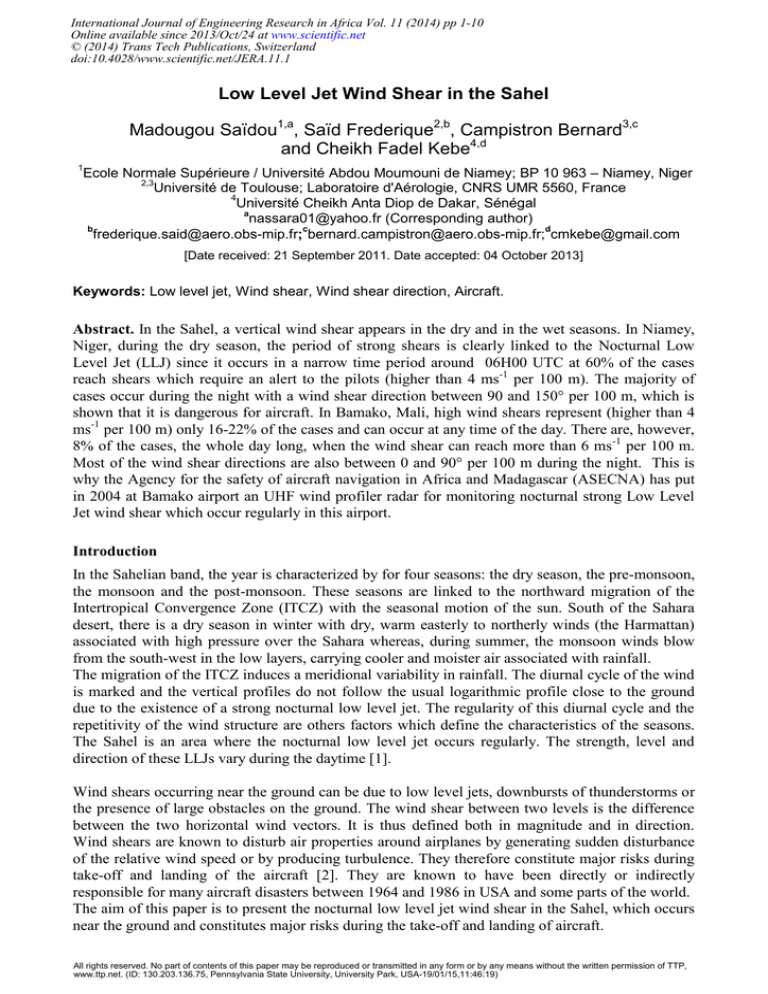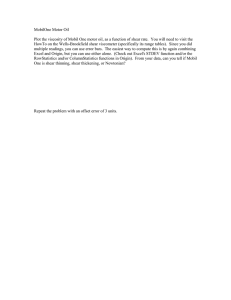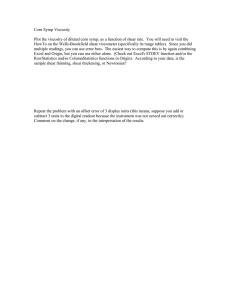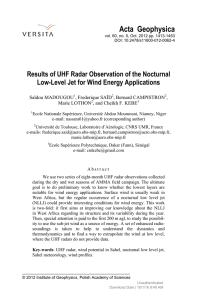
International Journal of Engineering Research in Africa Vol. 11 (2014) pp 1-10
Online available since 2013/Oct/24 at www.scientific.net
© (2014) Trans Tech Publications, Switzerland
doi:10.4028/www.scientific.net/JERA.11.1
Low Level Jet Wind Shear in the Sahel
Madougou Saïdou1,a, Saïd Frederique2,b, Campistron Bernard3,c
and Cheikh Fadel Kebe4,d
1
Ecole Normale Supérieure / Université Abdou Moumouni de Niamey; BP 10 963 – Niamey, Niger
2,3
Université de Toulouse; Laboratoire d'Aérologie, CNRS UMR 5560, France
4
Université Cheikh Anta Diop de Dakar, Sénégal
a
nassara01@yahoo.fr (Corresponding author)
b
frederique.said@aero.obs-mip.fr;cbernard.campistron@aero.obs-mip.fr;dcmkebe@gmail.com
[Date received: 21 September 2011. Date accepted: 04 October 2013]
Keywords: Low level jet, Wind shear, Wind shear direction, Aircraft.
Abstract. In the Sahel, a vertical wind shear appears in the dry and in the wet seasons. In Niamey,
Niger, during the dry season, the period of strong shears is clearly linked to the Nocturnal Low
Level Jet (LLJ) since it occurs in a narrow time period around 06H00 UTC at 60% of the cases
reach shears which require an alert to the pilots (higher than 4 ms-1 per 100 m). The majority of
cases occur during the night with a wind shear direction between 90 and 150° per 100 m, which is
shown that it is dangerous for aircraft. In Bamako, Mali, high wind shears represent (higher than 4
ms-1 per 100 m) only 16-22% of the cases and can occur at any time of the day. There are, however,
8% of the cases, the whole day long, when the wind shear can reach more than 6 ms-1 per 100 m.
Most of the wind shear directions are also between 0 and 90° per 100 m during the night. This is
why the Agency for the safety of aircraft navigation in Africa and Madagascar (ASECNA) has put
in 2004 at Bamako airport an UHF wind profiler radar for monitoring nocturnal strong Low Level
Jet wind shear which occur regularly in this airport.
Introduction
In the Sahelian band, the year is characterized by for four seasons: the dry season, the pre-monsoon,
the monsoon and the post-monsoon. These seasons are linked to the northward migration of the
Intertropical Convergence Zone (ITCZ) with the seasonal motion of the sun. South of the Sahara
desert, there is a dry season in winter with dry, warm easterly to northerly winds (the Harmattan)
associated with high pressure over the Sahara whereas, during summer, the monsoon winds blow
from the south-west in the low layers, carrying cooler and moister air associated with rainfall.
The migration of the ITCZ induces a meridional variability in rainfall. The diurnal cycle of the wind
is marked and the vertical profiles do not follow the usual logarithmic profile close to the ground
due to the existence of a strong nocturnal low level jet. The regularity of this diurnal cycle and the
repetitivity of the wind structure are others factors which define the characteristics of the seasons.
The Sahel is an area where the nocturnal low level jet occurs regularly. The strength, level and
direction of these LLJs vary during the daytime [1].
Wind shears occurring near the ground can be due to low level jets, downbursts of thunderstorms or
the presence of large obstacles on the ground. The wind shear between two levels is the difference
between the two horizontal wind vectors. It is thus defined both in magnitude and in direction.
Wind shears are known to disturb air properties around airplanes by generating sudden disturbance
of the relative wind speed or by producing turbulence. They therefore constitute major risks during
take-off and landing of the aircraft [2]. They are known to have been directly or indirectly
responsible for many aircraft disasters between 1964 and 1986 in USA and some parts of the world.
The aim of this paper is to present the nocturnal low level jet wind shear in the Sahel, which occurs
near the ground and constitutes major risks during the take-off and landing of aircraft.
All rights reserved. No part of contents of this paper may be reproduced or transmitted in any form or by any means without the written permission of TTP,
www.ttp.net. (ID: 130.203.136.75, Pennsylvania State University, University Park, USA-19/01/15,11:46:19)
2
International Journal of Engineering Research in Africa Vol. 11
Materials and Methods
Our data were obtained from two wind profiler radars installed at Bamako in 2005 and at Niamey in
2006 and cover two eight-months of observations collected during the dry and wet seasons of the
African Monsoon Multidisciplinary Analysis (AMMA) field campaign in West Africa. These wind
profiler radars provided continuously vertical profiles of the wind with a good time resolution
associated with the documentation of the vertical profile of the wind.
Figure 1 AMMA field observation extends from the edge of Atlantic Ocean in West Africa to the coast
of Central Africa, including Lake Chad and the Gulf of Guinea. The measurements presented here
were acquired in Niamey and Bamako (red dots) which are located in the Sahel band (red dashed
lines)
Bamako and Niamey are situated in the Sahelian band and are roughly 100 km apart in latitude.
Niamey is at 13°29’N, 2°10’E and 227 m asl in south west Niger and Bamako at 12°32’N, 7°57’W
and at 380 m asl in south west Mali (Figure 1). The radar installed at Bamako is an UHF PCL 1300
(Figure 2a) to monitor the nocturnal strong low-level wind shears that regularly compromise the
safety of aircraft on landing and take-off. This radar was operated during 2005 from March 4th until
December 29th without interruption except for an inactive period from May to June due to technical
problems. This radar suffered from technical problems after December 2005, even after repair, the
data were no longer recorded.
Figure 2a Bamako UHF PCL 1300 Wind profiler radar
The second radar (Figure 2b) was installed at Niamey airport in March 2006 during the AMMA
EOP in the framework of the US ARM program (Atmospheric Radiation Measurements) and
provided data from April 4th, 2006 to January 6th, 2007, except for an inactive period from June 17th
to July 2nd.
International Journal of Engineering Research in Africa Vol. 11
3
Figure 2b Niamey UHF Wind profiler Doppler radar
UHF radar measures wind vertical profiles and backscattered signal strength between about 0.1 and
3-5 km depending on the conditions of the atmosphere. It operates by transmitting electromagnetic
energy into the atmosphere and measuring the strength and frequency of the backscattered energy
and can work in clear air or during precipitation events. The radars provide vertical profiles of the
three components of the mean wind, turbulence parameters, Atmospheric Boundary Layer (ABL)
top Zi and qualitative information on precipitation and air humidity. In clear air, the atmospheric
signal is due to the backscattering by spatial irregularities of the air refractivity index at the scale of
half the radar wavelength when the source of the fluctuations comes from turbulent mixing which
follows the behavior of the Kolmogorov inertial subrange. Air refractivity depends on temperature
and humidity, the latter dominating in the lower atmosphere. The observation made by those two
Doppler profilers was based on a repetitive sequence cycling over the five beams, of 5.23-min
duration in Niamey and 2.5-min in Bamako, and comprising a high and low collection mode.
Vertical profiles of the wind are deduced from the Doppler spectra obtained at each level gate of the
five radial directions for each cycle of measurements. The three wind components are deduced from
the mean Doppler radial velocity measured on all beams with the assumption of local horizontal
field homogeneity. Only the low mode will be used here. The difficulty of operating with profiler
radar used in clear air is the fact that the meteorological echoes (produced by the wind) are very
faint relative to the noise. So the data processing is rather complex.
Results and Discussion
Nocturnal Low-Level Jet Description: Figure 3 shows the monthly vertical profiles of wind speed
observed at Bamako and Niamey at 00H00, 06H00, 12H00, 18H00 and 21H00 UTC during the four
characteristic periods: April at Bamako and May at Niamey for the pre-monsoon period, August,
October and December for the monsoon, post-monsoon and dry season respectively at both sites.
These figures show an increase of wind speed between 200 and 800 m with a well marked
maximum between 00H00 and 06H00 UTC, especially during the dry or pre-monsoon periods. This
Nocturnal Low Level Jet is much less marked during the monsoon period. In general, the jet is not
yet formed at 18H00 UTC and sometimes not even at 21H00 UTC, as was shown by Malcher and
Kraus [3]. The maximum jet (wind speed of about 14 ms-1) occurs during the dry season at 06H00
UTC. The maximum of the jet is not located at a constant level in the different figures: the jet peak
corresponds to the top of the stable nocturnal layer [2] and its evolution is linked to the evolution of
the stability conditions. In our data set, most of the time the jet level increases between 00H00 and
06H00 UTC which is in agreement with the stability evolution. Despite the variability of profiles,
the repetition of the structure of the jet in the low troposphere has enabled a composite day to be
developed, corresponding to the average of profiles every half-hour for each month. The height-time
cross sections in Figure 4 show the composite days of the horizontal wind in August and December.
4
International Journal of Engineering Research in Africa Vol. 11
(i-a) Pre-monsoon at Bamako
(i-b) Pre-monsoon at Niamey
(ii-a) Monsoon at Bamako
(ii-b) Monsoon at Niamey
(iii-a) Post-monsoon at Bamako
(iii-b) Post-monsoon at Niamey
(iv-a) Dry season at Bamako
(iv-b) Dry season at Niamey
Figure 3 Vertical profiles of wind speed observed at night (00H00; 06H00; 18H00 and 21H00 UTC), at
Bamako in 2005 and (b) Niamey in 2006 (i) Pre-monsoon, (ii) Monsoon, (iii) Post-monsoon, (iv) Dry
season.
During the rainy season (Figures 4a and 4b), the African Easterly Jet (AEJ) is positioned at the
latitudes of Niamey and Bamako, and blows steadily from east to west, spreading from 3 to 5.5 km
agl and peaking around 15 ms-1 at both locations, as shown by Kalapureddy et. al. [4]. The Inter
Tropical Discontinuity (ITD) is located between 15 and 20° north, and the low layers are affected by
a weak monsoon flow (less than 3 ms-1), blowing from the south-west.
International Journal of Engineering Research in Africa Vol. 11
5
The interface between the monsoon and the Harmattan is roughly at 1000 m. A cell of stronger wind
appears at night: it corresponds to the LLJ which brings moisture from lower latitudes into a thin
layer close to the surface as described in Lothon et. al. [5]. It only reaches 5-7 ms-1 on average
during the rainy season. This jet is much more marked during the dry season (Figure 4c and 4d)
when it reaches 13 ms-1. Its direction is then north-east, which is also the direction of the Harmattan,
which blows up to 2-3 km. Above 4 km, we find the Subtropical Westerly Jet. The only difference
between Bamako and Niamey is the intensity of the Harmattan in the middle of the day. In both
locations, the LLJ disappears with the morning onset of turbulence and the wind weakens in Niamey
in the low layers (5-6 ms-1) as described in Madougou et. al. [6].
An example of the characteristics of the lower troposphere is presented in Figure 5 and Figure 6 as
height-time cross sections of horizontal wind, reflectivity and dissipation rate of turbulent kinetic
energy, observed at Bamako from April 26th to 29th, 2005 and at Niamey from May 3rd to 6th, 2006.
Figure 5a and 6a clearly show the LLJ. These periods correspond to the time when the ITD is
located near Bamako and Niamey. It results in an alternation between the two wind regimes in the
lower layers, the monsoon at night and the Harmattan during daytime, because the ITD moves
southwards during the day and northwards during the night in connection with the diurnal cycle of
the Saharan depression heat.
(a)
(b)
(c)
(d)
Figure 4 Composite days of the horizontal wind in August (a) at Bamako in 2005 and (b) at Niamey in
2006, and in December (c) at Bamako in 2005 and (d) at Niamey in 2006. The color scale shows the
intensity of the wind speed
In the early morning, the jet can reach 10 ms-1 and its depth can grow to 1200 m. This jet is roughly
centered at 06H00 UTC and disappears shortly after 10H00 UTC. During this period, the monsoon
blows from the south-west, advecting moisture at low levels and generating a high wind shear and a
6
International Journal of Engineering Research in Africa Vol. 11
strong gradient of humidity at its top, above which the Harmattan blows. These shears and humidity
gradients produce reflectivity maxima, which are well marked in Figures 5b and 6b. In these figures,
some reflectivity maxima appear in the night. Those correspond to the upper part of the jet. After
sunrise, the thermal turbulence grows and gradually destroys the jet. The development of the
atmospheric boundary layer (the top of the ABL is indicated by the maximum of the reflectivity,
symbolized by black dots in the figures) starts slowly in the morning (before 10H00 UTC) and
accelerates once the wind weakens. The top of the atmospheric boundary layer can reach 4-5 km
(April 26th at Bamako, May 4th at Niamey). The development of the ABL also appears between
12H00 and 18H00 UTC in Figures 5c and 6c, where the dissipation rate of turbulent energy is
represented. On the other hand, the high nocturnal values of dissipation remain unexplained so far.
(a)
(b)
(c)
Figure 5 Height-time cross sections of (a) horizontal wind, (b) reflectivity and (c) dissipation rate of
turbulent kinetic energy, obtained at Bamako from April 26th to 29th, 2005. Black dots indicate the top
of the inversion layer at night or the top of the ABL during daytime
(a)
(b)
(c)
Figure 6 Height-time cross sections of (a) horizontal wind, (b) reflectivity and (c) dissipation rate of
turbulent kinetic energy, obtained at Niamey from May 3rd to 6th, 2006. Black dots indicate the top of
the inversion layer at night or the top of the ABL during daytime
Wind Shear: The wind shear between two levels is the difference between the two horizontal wind
vectors. It is thus defined both in magnitude and in direction:
WS mag
u 2 v 2
z z
1/ 2
(1)
International Journal of Engineering Research in Africa Vol. 11
WS dir
u
z
arctg
v
z
7
(2)
Wind shears are known to disturb air properties around airplanes by generating sudden disturbance
of the relative wind speed or by producing turbulence. They therefore constitute major risks during
take-off and landing [2]. They are known to have been directly or indirectly responsible for many
aircraft disasters between 1964 and 1986 in some parts of the world and especially in the USA,
where traffic is very heavy (see the statistics of aircraft accidents related to wind shear in the Federal
Aviation Administration circular)[7].
Shears occurring near the ground can be due to low level jets, downbursts of thunderstorms or the
presence of large obstacles on the ground (mountains, large buildings, etc.). In the Sahel lower
troposphere, a vertical wind shear also appears between the monsoon layer and the Harmattan layer,
as was seen (Figure 7) between 1000 m and 1500 m in August. This shear is not dangerous, because
it is not too close to the surface and secondly, because the wind intensity is very low in this area. In
contrast, the shear generated by the low level jet is far more dangerous.
Some studies [8] calculated the magnitude of the wind shear between 30 and 300 m, from SODAR
observations installed in the framework of AMMA on sites located about sixty kilometers east of
Niamey. The first author is a forecaster at the National Meteorology Directorate of Niamey and he
knows the standards of safety procedures for aircraft taking off or landing at an airport. In practice,
an alert is triggered when the wind speed measured by the radiosonde at 600 m is above 30 knots
(15 ms-1). Considering that the wind shear is maximum between 0 and 300 m, from the observations
they made between the beginning of June and mid-August, this threshold of 15 ms-1 corresponds to
a wind shear of 5 ms-1 per 100 m. Kaplan et. al. [9], who described a series of measurements made
near Dallas airport in the Great Plains of the USA, indicates that the average shear is 2.9 ms -1 per
100 m at 200-300 m, i.e. below the maximum LLJ, located at 500 m on average.
Wind Shear Characteristics in the Sahel and its Consequences: Figure 7 shows the frequency
distributions of wind shear magnitude and wind shear direction versus time, between 150 and 300 m
at both sites, during the dry season and pre-monsoon period. The magnitude occurrences are spaced
2 ms-1 per 100 m and the direction occurrences 30° per 100 m.
In Niamey during the dry season, the period of strong shears is clearly linked to the LLJ since it
occurs in a narrow time period around 06H00 UTC: 60% of the cases reach shears which require an
alert to the pilots (higher than 4 ms-1 per 100 m) (Figure 7 (b)). Such high shears can also be found
at the same time in 20% of the occurrences in the 300-500 m layer (not shown). These high shear
values are within the Harmattan wind but, since the LLJ is stronger during this season, with a peak
level closer to the surface, the shear magnitude is stronger. The majority of cases occur during the
night with a wind shear direction between 90 and 150° per 100 m (Figure 7 (d)), which is also
dangerous for aircraft (cross-wind). In Bamako, high wind shears (higher than 4 ms-1 per 100 m)
represent only 16-22% of the cases and can occur at any time of the day (Figure 7 (a)). There are,
however, 8% of the cases, the whole day long, when the wind shear can reach more than 6 ms-1 per
100 m. Most of the wind shear directions are also between 0 and 90° per 100 m (Figure 7 (c)) during
the night.
8
International Journal of Engineering Research in Africa Vol. 11
(a)
(b)
(c)
(d)
(e)
(f)
(g)
(h)
Figure 7 Frequency distributions of wind shear versus time: (a, b, e, f) in magnitude and (c, d, g, h) in
direction observed in Bamako (left) or Niamey (right), during the dry or pre-monsoon periods
During the pre-monsoon period, high wind shears are not so frequent, either in Niamey or in
Bamako (Figures 7 (e) and (f)). The highest shears occur mostly at night (17% of the cases in
Niamey and 20% in Bamako). In Bamako, the wind shear direction is almost equally distributed
over the whole range of wind sectors (Figure 7 (g)). In Niamey, 55% of the night cases are in the
210-270° sectors, which is also dangerous for aircraft (Figure 7 (h)). The monsoon period (Figure 8
(a), (b), (c) and (d)) and post-monsoon period (not shown), revealed very rare high wind shears.
International Journal of Engineering Research in Africa Vol. 11
9
Abdou et. al. [8] found higher wind shears in magnitude between 30 and 300 m during a period
spanning May 31st to August 17th (i.e. from the pre-monsoon to the monsoon period) with 18 to
38% of wind shears greater than 4 ms-1 per 100 m. The discrepancy between their results and ours
probably stems from the fact that higher wind shears also occur between 30 m and 150 m, in a range
that cannot be reached by the UHF radar.
(a)
(c)
(b)
(d)
Figure 8 Frequency distributions of wind shear versus time: (a, b) in magnitude and (c, d) in direction
observed in Bamako (left) or Niamey (right), during the dry or pre-monsoon periods
Conclusion
This study shows that the strongest values of LLJ are encountered during winter, which corresponds
to the dry season or during the transition period between the dry and the wet seasons. Associated
with these strong values of LLJ, large wind shear, either in magnitude or direction, appear in the
vicinity of the nocturnal jet. The probabilities of strong wind shear are most important between 150
and 270 m. In the LLJ period, in Niamey it found 60% of cases of shear higher than 4 ms-1 per 100
m between 150 and 270 m and 20% between 270-500 m. Shears higher than 4 ms-1 per 100 m,
appear in Bamako, where the pre-monsoon wind shear frequencies vary from 10 to 20% at 4-6 ms-1
per 100 m, at the LLJ time (21H00 to 06H00). There are even cases, but less probable, where the
wind shear can reach 6-8 ms-1 per 100 m. In Niamey, the period to worry is between 03H00 and
06H00, which corresponds to the maximum of the LLJ. These shears of low layers are the most
dangerous for aircraft. Both profilers were located in the airport area, which enabled accurate
information to be provided to the pilots, who otherwise received conflicting measurement
indications from their on-board instruments and the control tower.
10
International Journal of Engineering Research in Africa Vol. 11
Acknowledgments
The authors of this work thank the University Abdou Moumouni (Niamey, Niger) and the INSUCNRS authorities. We would like to give special thanks to ASECNA for providing us the UHF
profiler data in Bamako. We also thank the US Atmospheric Radiation Measurement program for
operating the UHF wind profiler in Niamey and providing us the data.
References
[1] Madougou Saïdou; Saïd Frederique; Campistron Bernard; Lothon Marie; and Cheikh Fadel
Kebe, Results of two eight-month, UHF radar observations of the nocturnal low-level jet for wind
energy applications. Acta Geophysica. 60(5) (2012) 1413-1453, DOI: 10.2478/s11600-012-0062-4
[2] A.K. Blackadar, Boundary layer and maxima and their significance for the growth of nocturnal
inversions. Bull. Amer. Meteor. Soc. 38 (1957) 283–290.
[3] J. Malcher and H. Kraus, Low-level jet phenomena described by an integrated dynamical PBL
model. Bound.-Layer Meteor. 27 (1983) 327-343.
[4] Kalapureddy, M. C. R., M. Lothon, B. Campistron, F. Lohou, and F. Saïd, Wind profiler
analysis of the African Easterly Jet in relation with the Boundary-layer and the Saharan Heat Low.
Quart. J. Roy. Meteor. Soc. 136 (1) (2010) 77-91. DIO 10.1002/qj.494.
[5] Lothon, M., F. Saïd, F. Lohou and B. Campistron, Observation of the diurnal cycle in the low
troposphere of West Africa. Mont. Wea. Rev., 136 (2008) 3477-3500.
[6] Madougou, S.; B. Campistron; F. Said; M. Lothon; F. Lohou and G. Canut Nine months of uhf
wind profiler radar observation of low atmosphere at Bamako and Niamey. 2nd International
AMMA Conference, 26 - 30 November (2007), Karlsruhe (Germany).
[7] Federal Aviation Administration. Pilot wind shear guide: advisory circular AC N°00-54. US
department of transportation (USA), (1988) 64 pp. Available online at
http:
//rgl.faa.gov/Regulatory_and_Guidance_Library/rgAdvisoryCircular.nsf/list/AC%2000-54/
$FILE/AC00-54.pdf
[8] Abdou, K., D.J. Parker, B. Brooks, N. Kalthoff and T. Lebel, The diurnal cycle of lower
boundary layer wind in the West African monsoon. Quart. J. Roy. Meteor. Soc. 136 (1) (2010) 6676. DIO 10.1002/qj.536.
[9] Kaplan, M.L., Y.L Lin., J.J. Charney, K.D. Pfeiffer, D.B. Ensley, D.S. DeCroix, R.P. Weglarz,
A terminal area PBL prediction system at Dallas-Fort Worth and its application in simulating
diurnal PBL jets. Bull. Am. Met. Soc. 81(2000) 2179-2204.
International Journal of Engineering Research in Africa Vol. 11
10.4028/www.scientific.net/JERA.11
Low Level Jet Wind Shear in the Sahel
10.4028/www.scientific.net/JERA.11.1





